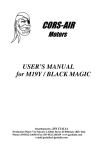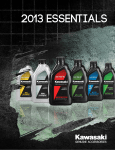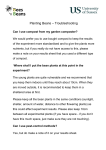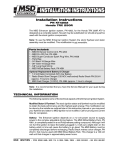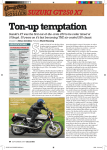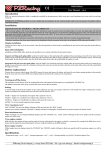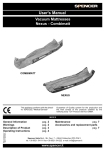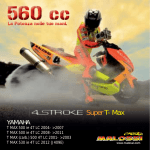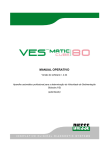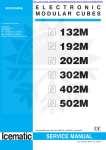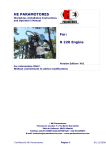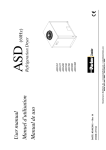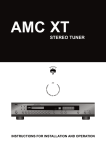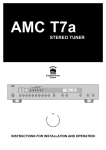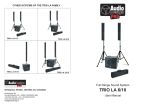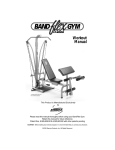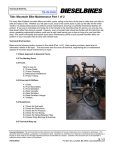Download M21Y Air User `s Manual
Transcript
CORS-AIR MOTORS USER’S MANUAL ENGINE M 21 Y Distributed by: JPX ITALIA Via Flli. Cervi n°3 42025 Cavriago (Reggio Emilia) Italy Phone (39) 0522-371682 Phone/Fax :(39) 0522-372875 Mob. 333-4563008 www.jpxitalia.com INTRODUCTION Thank you for choosing our engine CORS-AIR M 21 Y. Herewith we invite you to spend some time reading this manual, which will let you discover all the features of your engine. Advices on maintenance and recurrence of controls will help you to have an always reliable engine and to preserve your investment. We invite you furthermore to deliver this manual together with the engine if you sell it; this will be useful to the next owner, too. The manufacturer and the resellers are ready to answer your questions and, if necessary, to solve every problem, because YOUR AND THE OTHER PEOPLE’S SAFETY IS THE MOST IMPORTANT THING FOR US. IDENTIFICATION OF THE OWNER Owner Address Serial number Reseller Address Owner’s signature Reseller’s signature and stamp Date of sale The Company reserves the right to make technical and aesthetic changes without notice, in order to improve the quality of the product. TECHNICAL FEATURES Engine M 21 Cycle 2 strokes Power 21 hp at 7200 rpm Total displacement 172,5 c.c. Bore 65 mm. Stroke 52 mm. Compression ratio 11:1 Peak rpm 7.400 rpm Cooling by air Piston of light alloy with 2 piston ring of cast iron S10 chrominiumplated Cylinder of silicon light alloy with surfacing of Cermetal Head of die-casted light alloy with high percentage of silicon Crankcase molten in alloy G –Al Si 9 UNI 3051 Connecting rod of steel 18 Ni Cr Mo 5 forged and copperplated with rolls fit for high speed Carburettor Walbro WB 32 Feeding reed valve with 4 petals on the crankcase Electronic ignition type CDI with double spark per round with battery recharge included Generated current at 6.000 rpm 85 Watt 6,6 Amp. Regulation of spark lead 18° at 7000 rpm Spark plugs NGK B8ES (for normal or hot climate) B7ES (for cold climate) Reductor with belt Poly-V from 1 to 1.9 to 1 to 2.6 Continuous normal temperature not over 200°C Fuel mixture of premium petrol 98 octane and oil running-in and with hot climate, 2% normally Oil synthetic top-quality oil for 2-strokes engines Expenditure from 2,5 to 4,5 liter/hour depending from the load and the speed Fixing to the frame 5 rubber antivibration mounts Rotation counterclockwise in front of the propeller MAIN TORQUES NUTS TO FIX THE HEAD NUTS TO FIX HALF-CRANKCASE BOLTS TO FIX THE REDUCTOR FLANGE TO THE CRANKCASE BOLTS TO FIX THE BACK FLANGE TO THE CRANKCASE NUTS TO FIX THE FRONT PART OF THE DRIVE SHAFT TO THE PINION NUTS TO FIX BACK PART OF DRIVE SHAFT TO IGNITION HANDWHEEL Kg.m (Nm) 1,8 2 2 2 4 18 20 20 20 40 3,5 35 ASSEMBLY: You can fix the engine on the frame by interposing 4 rubber mounts of O 40 mm between the back flange and the engine mount. It is necessary to install also the 5th rubber mount, fixing it in the proper hole located under the reduction flange, through an angular square. This device will permit to distribute homogeneously the vibrations of the engine on every part of the frame. To fix the propeller use only bolts of class 10/8 (100 Kg) and make sure that their length is enough to exit from the reductor-pulley. Tighten the 6 bolts M8 in a cross, at 1.5 Kg.m.(15Nm). Re-check the tightening of the bolts after the first hour of engine’s working. For the connection between the carburettor and the fuel tank use a proper linen pipe of the right section (1,2 times the max. expenditure per hour, that means sending 11 liters/hour). The length of the pipe must not be more than 80 cm. It is advisable to install a manual pump to let the fuel arrive before the start of the engine. This device will avoid the protraction of the switching on to let the mixture arrive to the carburettor, protecting this way the battery. IMPORTANT NOTES DO NOT try to start the engine without the propeller. DO NOT make the engine work with loose bolts, since this can cause the detaching of the propeller, the ovalization of the propeller holes, the damage of the electric start and the breakage of the rubber mounts. IMPORTANT! BEFORE FLYING CHECK ALWAYS EVERY PART OF YOUR CRAFT, FROM THE ENGINE TO THE FRAME. Verify that there are no cables of the electric plant damaged, that there are no fuel losses from pipes, tank, carburettor or engine’s crankcase, that the propeller is not damaged or loose, that the exhaust-pipe has no cracks, that the frame is not bended or broken because of falls, that rubber mounts are whole, that the reductor belt is not loose, that every bolt is tightened. Finally you can switch on the engine, leaving it warm up at a speed from 2.000 to 2.500 rpm. Now you can take off and enjoy a pleasant flight. FUEL Use for the mixture only premium petrol for cars 98 octane, together with goodquality, synthetic oil for mixtures, in a quantity of 2.5% during the running-in and 2% afterwards.(DO NOT USE MIXTURE ALREADY DONE AT PETROL PUMPS). IMPORTANT: with very hot climate and high temperatures use PERCENTAGE 2.5%. When you prepare the mixture, make sure that the can has not dirt or water in it, put always the oil first and shake a lot. Never let the engine work without the carburettor air-filter, because dirt and dust raised by the propeller can damage it. ADJUSTMENT OF THE CARBURETTOR The carburettor has two screws for adjustment, 1 screw signed L adjusting idle speed during low speed and 1 screw signed H for high speed. In order to make the adjustment, tighten clockwise then unscrew: screw L 1/4 (a quarter) round, screw H 1 1/2 (one and a half) round -adjustment with filter Air Box, we advise this kind of air-filter. Furthermore, we advise to put a small security-cable on the air filter, to avoid that it can come off-. These adjustments can be different on the basis of weather conditions and flight altitudes. Ideal mixture is reached when the insulator of the spark plug is white coffee-coloured; if the colour is black, the mixture is too rich, therefore turn screw H clockwise 1/8 round per time. If the spark plug is grey/white, the mixture is weak, therefore turn screw H counterclockwise always 1/8 round per time. Remember that if the mixture is too weak, THE PISTON CAN SEIZE. You can better see the colour of the spark plug by keeping the engine for 20 seconds at maximum speed and switching it off suddenly without letting it slow down. Once you have found the perfect mixture do not change it unless you change flight place or climate conditions, since register screws can be damaged by continuous adjustments. RUNNING-IN All CORS-AIR engines, before being delivered, are subject to a severe qualitycheck at test bench for 15 minutes, in order to verify if all the components respect the fixed parameters, but a further running-in is anyway necessary. A GOOD RUNNING-IN WILL PROLONG THE LIFE OF YOUR ENGINE. Go to a quiet place, put a thick rubber carpet under your craft to avoid that stones or other things damage the propeller by putting it on earth and act like this: let the engine work at a speed of 2500 rpm for 5 minutes, then regulate speed at 3000/3500 rpm for 15 minutes, then at 4000 rpm for other 15 minutes. Switch off the engine and check that there are no loose nuts or bolts and that every component is ok. BE CAREFUL NOT TO TOUCH HOT PARTS (POWER UNIT AND EXHAUST PIPE). Start the engine again and take it step by step to 4000 rpm for 5 minutes, then accelerate to 4500 rpm for 15 minutes. After these 15 minutes, make short but steady accelerations for 1 minute, without reaching peak rpm. During the first 4 hours, do not subject the engine to extreme efforts and speed. MAINTENANCE - Every 20 hours: Check the condition of the spark plug and the distance between the electrode and the insulator (0.7 mm) Clean the carburettor air-filter, the carburettor filter placed at the end of the fuel pipe and the filter of the fuel tank Check the tighten of every bolt Tighten (in cross order) the 4 bolts of the power unit with a dynamometric spanner at 1.8 Kg.m (18Nm) Check the tension of the reductor belt and its condition Check petrol pipes Check the cables of the electric plant Grease the link-sphere between the manifold and the exhaust pipe with lubricating copper-grease suitable for high temperature (up to 1100°). If you can’t find it on the market , please ask your dealer. - Every 50 hours Same controls of the 20 hours and furthermore: Check the tighten of the engine’s crankcases Change spark plugs Check the reductor belt and the play of the pulley and change them in case of need Check the conditions of the start crown wheel Once a year (independently from flight hours) change the diaphragm of the carburettor N.B. It is advisable to keep complete records of all maintenance in a log book for the engine. On request, it is possible to buy a proper tool hour/rev counter, which works also as instrument to control the head temperature at sight (CHT). TENSION OF THE REDUCTOR BELT Loose the security bolt placed high behind the reduction plate, loose the one placed always on the reduction plate high on the side and act clockwise with a spanner n. 27 on the cam shaft that fixes the pulley. ATTENTION: only in case of emergency use the red-coloured central bolt placed in the middle of the pulley to pull the belt tight; in that case DO NOT TURN IT ABSOLUTELY COUNTER-CLOCKWISE, since it is a security device. Once you’ve finished this operation, tighten the side-bolt of the plate and the security back bolt. Do not tighten the belt too much because the bearings could get damaged. STORAGE OF THE ENGINE FOR A LONG TIME In case the engine is not used for a long time, act like this: Empty the fuel tank, included the pipes and the carburettor Disassemble the battery Unscrew the spark plug and put into the hole a teaspoon of oil for engines, then re-assemble the spark plug letting the propeller turn slowly by hand for 2 or 3 times completely. Disassemble the propeller Loose the reductor belt Close the hole of the exhaust pipe Cover everything with a blanket and put it in a dry place Once a month charge the battery and let the pinion of the drive shaft turn by hand 2 or 3 times completely. WARRANTY CORS-AIR engines are manufacture with top-quality material, therefore warranty is valid also for their accessories. DURATION OF WARRANTY 1 YEAR beginning from the date of sell or exit from JPX ITALY Warranty includes spare parts and labour, transport excluded. WARRANTY IS VOID IN THE FOLLOWING SITUATIONS: - Alterations to the engine not approved by JPX Italia. - Wear & tear of components of the engine due to the instructions within the product manual not being adhered to. - Accidental falls or dropping of the engine or its components. - Overheating and seizure of the engine due to prolonged high speed running of the engine, running with excessive loads, running with inadequate loads, running with insufficient oil in the petrol or running with petrol only (oil mixture omitted). - The presence of dirt, sand or foreign bodies in the carburettor of the engine. - Corrosion through bad storage of the engine or inadequate preparation for storage of the engine. - Running the engine without an air-filter fitted to the carburettor. - Miss-assembly of engine parts or components not assembled by JPX Italia or official dealers and supplied disassembled for packing and transport purposes. - Corrosion of the engine or components emanating from stone chips or any other impact or abnormal stress damage. - Work other than the maintenance set out in the product manual having been carried out on the engine by anyone other than JPX Italia or official dealers. - Incidental or consequential loss or damage. - Service bulletins from JPX Italia or official dealers not having been adhered to. - Engine used for racing use. JPX ITALY AND ITS RESELLERS REMAIN AT YOUR DISPOSAL FOR EVERY INFORMATION AND ADVICE ABOUT THE USE OF THE ENGINE. SEARCH FOR FAILURES THE ENGINE DOES NOT START Check: switch on-off cable of the spark plug play between electrode and baked clay all the connections of the electric plant that fuel arrives correctly from the tank to the carburettor FLOODED ENGINE Dismantle the spark plug and dry it well ; before re-assembling it, let the propeller turn slowly 2/3 times. THE ENGINE DOES NOT BEARS IDLE SPEED OR HAS AN IRREGULAR SPEED Check, after dismantling it, if the petals of the reed valve are hermetically sealed at stroke-end. If you put them against a light source (lamp or sun), light should not pass, otherwise you must change the petals with identical ones. THE ENGINE CANNOT REACH MAXIMUN SPEED Check that the cable of the accelerator runs regularly. Check that there is neither dirt in the carburettor- or tank-filter nor narrow points in the fuel pipe, due to too tight curves Check the spark plug; is it’s worn, change it with one of the same brand and same thermic degree. SOME FINAL IMPORTANT ADVICE NEVER switch on the engine with people beside or in front of the propeller, or anyway near. The BREAKAGE of a propeller can cause very severe hurts even several metres away. ALWAYS CHECK at sight your craft before and after the flight, so that you can see if some piece is loose, damaged or presents anomalies. DO NOT keep engine at peak rpm after the take off, except for the absolutely necessary time and for emergencies (obstacles or sudden wind). If you use big propellers, REMEMBER that cooling is not perfect flying at high speed, so keep under control the temperature of the engine with proper instruments (CHT). Once you have found the perfect carburation, DO NOT modify it unless you change flying place going to much higher or lower altitudes or unless climate and temperature are very different from the ones where you fly usually. DO NOT FLY with bad weather conditions, you’ll fly the day after. REMEMBER: FLIGHT IS FOR FUN, NOT FOR RISKING YOUR LIFE! HAVE A GOOD FLIGHT AND ENJOY YOURSELF. SPACCATO MOTORE ENGINE SECTION TABLEAU DES MORCEAUX DU MOTEUR CODE N° ARTICLE 1) SPARK PLUGS NGK B8ES 2) HEAD 3) CYLINDER 4) TIE-ROD HEAD/CYLINDER (n° Pcs. 4) 5) GASKET OF THE HEAD 6)GASKET OF THE CYLINDER BED 7) UPPER HALF-CRANKCASE 8) LOWER HALF-CRANKCASE 9) DRIVE SHAFT COMPLETE OF CONNECTING ROD 10)BEARING OF DRIVE SHAFT (n° Pcs. 2) 11)SEAL-RING OF DRIVE SHAFT (n° Pcs. 2) 12)PISTON COMPLETE OF PISTON-PIN AND LOCK 13)PISTON RINGS (N° 2 pcs. together with the piston) 14)FLANGE AIR FILTER 15)CARBURETTOR WALBRO WB 32 16)GASKET OF CARBURETTOR 17)REED VALVE 18)FLANGE FOR CARBURETTOR BED 19)TIE-ROD FOR HALF CRANCKASE (n° Pcs.4) 20*)REDUCTION PULLEY (110 mm or 125 mm) 21*)REDUCTION BELT (POLY-V 483 or 509) 22)REDUCTION FLANGE 23)CROWN WHEEL OF STARTER 24*)PINION (50 mm or 55 mm or 60 mm) 25)CAM OF THE PULLEY 26)BEARING OF REDUCTION PULLEY (n° Pcs. 2) 27)STARTER 28)TRANSDUCER (COIL) 29)VOLTAGE REGULATOR 30)BUSH (ignition support) 31)IGNITION 32)HANDWHEEL 33)BACK SUPPORT BASE N.B. BOLTS AND NUTS ARE NOT MENTIONED SINCE THEY ARE INCLUDED IN THE PACKAGE OF THE SPARE PARTS. * FOR THE PIECES MARKED WITH AN ASTERISK PLEASE SPECIFY THE MEASURE.











